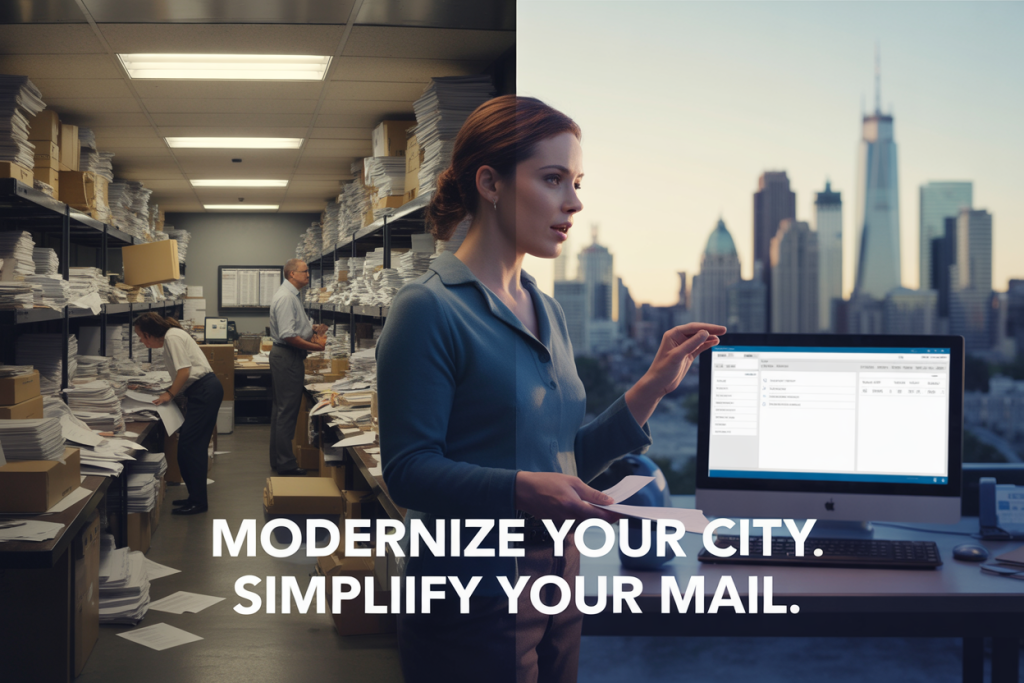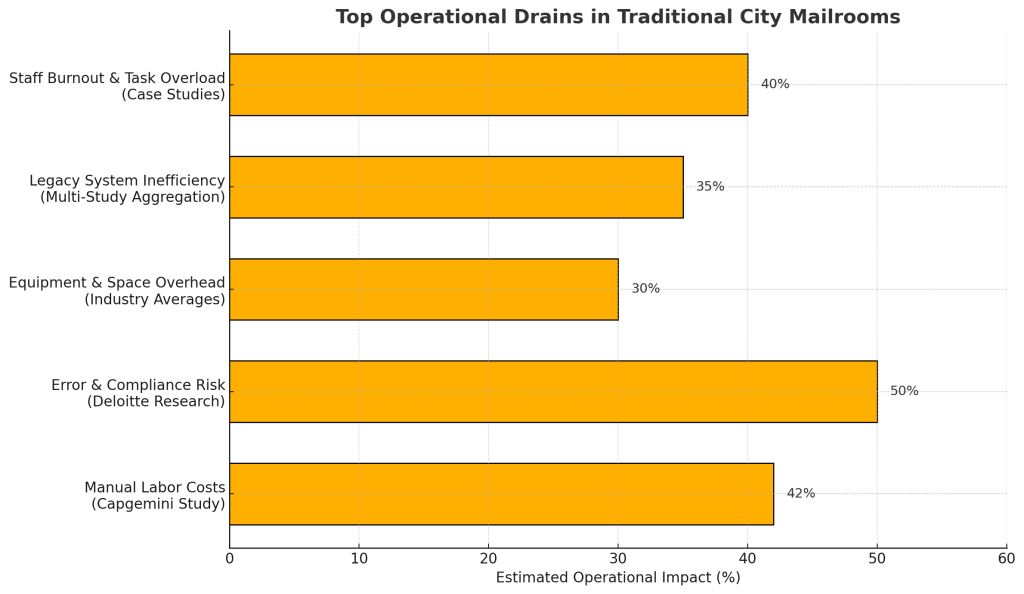How to Modernize Your City’s Mailroom Automation Without IT Overload

For many cities, the mailroom remains one of the most overlooked bottlenecks in public operations. What was once a routine, behind-the-scenes function has become a drain on staff time, budgets, and public trust. With rising expectations for government efficiency and fewer hands to do the work, cities can no longer afford to run mailrooms the old-fashioned way.
The good news? You don’t need a massive IT overhaul to fix it. If you’re looking to modernize your city mailroom without burdening your IT department, you’re not alone. Implementing city mailroom automation not only enhances efficiency but also improves service delivery in municipalities.
In this guide, we’ll walk through how modern municipalities are streamlining their mail operations using cloud-based, automated solutions like Postalocity, without overloading their IT teams or requiring new infrastructure.
Why Most City Mailrooms Are Broken (and Costing You More Than You Think)
Take a closer look at any city mailroom, and you’ll likely find the same thing: stacks of paper, overworked staff, and outdated equipment humming along to a process that hasn’t changed in decades. The real cost isn’t just in postage, it’s in the hours of manual labor, the errors from hand-entry, the space taken up by printers and storage, and the compliance risks when things slip through the cracks.
Many municipalities are still using legacy government mailing services that were never built for today’s demand. A Capgemini study found that manual mail handling can increase operational costs by as much as 42%. And in cities where staff wear multiple hats, mailroom duties often fall to employees who are already stretched thin. It’s not just inefficient, it’s unsustainable.
Digital solutions help eliminate manual mailing processes entirely. Cities using municipal mail automation solutions report 30% to 70% savings, and error rates drop by over 50%, according to Deloitte. If you’re still running a paper-based system, your city is absorbing unnecessary costs and risking compliance.

Source: Data reflects insights from Capgemini, Deloitte, and McKinsey research, combined with municipal case studies and industry benchmarks on government mailroom inefficiencies.
Top Reasons City Mailrooms Are Costing You More
- Manual labor is expensive and inefficient – Cities spend significant staff time printing, folding, stuffing, and stamping mail.
- High error rates lead to rework and compliance risk – Hand-entered addresses and manual tracking increase the chance of mistakes.
- Physical equipment and space drain resources – Printers, postage meters, and storage take up valuable office real estate.
- Legacy systems can’t keep up with demand – Outdated government mailing services weren’t designed for today’s communication volume.
- Staff multitasking leads to burnout – Employees tasked with mailroom duties are often pulled away from higher-priority responsibilities.
What Modernizing a City Mailroom Actually Looks Like
Contrary to what many assume, modernizing your mailroom doesn’t require ripping out systems or deploying complex new IT infrastructure. Instead, it’s about eliminating friction and replacing repetitive, manual tasks with streamlined, cloud-based processes that any staff member can manage.
With automated mailroom software for local government, platforms like Postalocity make the transition seamless. Staff simply upload documents through a secure web portal. The system handles USPS address validation, document formatting, postage application, and even barcode tracking. From there, the mail is printed, sorted, and sent—without anyone having to touch a printer, envelope, or stamp.
This form of mailroom workflow automation allows clerks and city staff to eliminate bottlenecks and get back to high-value work. And because the entire process is web-based, it can be managed from anywhere. Whether you’re in the office, working remotely, or overseeing multiple departments, you have full visibility and control without needing IT to support or maintain the system.
This isn’t a future vision, it’s already helping cities across the country modernize city mailrooms affordably and efficiently.
Who’s Actually Modernizing Their Mailrooms—and Why It Works
Automated mailroom solutions aren’t limited to the private sector. In fact, government and public sector entities are some of the biggest adopters, precisely because they’re under pressure to do more with less.
A growing number of cities are replacing government print and mail systems that are expensive, rigid, and outdated. The move toward city mailroom outsourcing reflects a larger trend toward automation in essential government communications.
Can small cities actually benefit from mailroom automation? Yes. In fact, smaller municipalities often see the biggest gains because they lack the staff and resources to support outdated manual processes.
Take a European utility provider that processed over 200,000 customer emails annually. By automating their mail operations, they cut turnaround times, reduced staff burden, and improved accuracy. A healthcare organization digitized more than 50,000 documents per month and reduced their processing window from seven days to two. Even a Fortune 500 bank consolidated over 20 mailrooms into just three digital hubs, improving delivery speed and eliminating inter-office mail inefficiencies.
For cities, the use cases are just as compelling. Utility bills. Tax notices. Public hearings. Legal mail. Election notifications. What used to take days now takes minutes, at a fraction of the cost and with zero risk of missed deadlines. More importantly, these solutions support how cities send utility bills and official notices—securely, on time, and at scale.
Common Fears About Mailing Automation (and How to Beat Them)
If you’ve hesitated to modernize because you fear the tech burden, you’re not alone. Many city leaders worry that switching to a digital mail solution means deploying new software, hiring consultants, or integrating systems across departments.
But that’s not the case here. Postalocity is fully cloud-based and requires no on-site installation, no dedicated hardware, and no specialized training. Your staff can be up and running in less than a day.
Security is often another concern—and rightfully so. Postalocity uses AWS-encrypted infrastructure and HIPAA-compliant protocols to ensure every piece of mail is handled securely. Updates, patches, and data backups are managed behind the scenes by the platform, so there’s no strain on your IT team.
Postal outsourcing for municipalities like yours isn’t about replacing your systems, it’s about simplifying the way you communicate with your community.
Pro Tip: The most successful cities approach mailroom modernization like they would a utility upgrade: low-friction, low-disruption, and high-impact. Focus on quick wins, and build confidence from there.
Step-by-Step: How to Transition Without Overwhelming Your Staff
The most common question city managers ask is: “What does the switch actually look like?” The answer is refreshingly simple.
Here’s what the transition typically involves:
- Week 1: Identify your key mailing workflows—utility bills, legal notices, etc.—and set up your Postalocity account.
- Week 2: Upload a sample document set. Postalocity will validate addresses, format mail, and prepare the batch for approval.
- Week 3: Approve your first live mailing. Track delivery status and monitor results from the dashboard.
- Week 4: Scale up. Begin routing more workflows through the platform and retiring manual steps.
City clerk mailing responsibilities don’t need to include envelope stuffing and postage metering anymore. Instead, with the right tools in place, those responsibilities evolve into managing communications, not performing them manually.
No consultants. No downtime. No new equipment. Most cities complete the transition in less than 30 days, with no strain on existing resources.
The ROI of a Digital Mailroom (Backed by Data)
Let’s talk numbers, because at the end of the day, every modernization effort needs to pay off.
Digital mailroom automation can reduce processing time by 80–90%, according to research from McKinsey and Capgemini. Operational costs drop by 30% to 70%, and productivity gains often reach 20–25%. One mid-sized agency saved over $500,000 in a single year.
Whether your goal is to reduce mailing costs for cities, eliminate physical infrastructure, or meet new compliance standards, a digital solution provides measurable value. Most cities that adopt digital mailing solutions see full return on investment in 6 to 18 months, with lasting savings well beyond.
Even more compelling: customer satisfaction scores improve. Why? Notices arrive on time. Errors are minimized. Residents feel informed, not ignored.
This isn’t just about cutting costs. It’s about building credibility through consistent, dependable communication.
Fact: A digitally automated mailroom can reduce operational costs by over 40% within the first year and pay for itself in as little as 6 to 18 months, based on real-world studies.
Ready to Modernize? Here’s Your First Smart Step
The old mailroom isn’t coming back, and that’s a good thing. Modernizing your city’s mailing process is easier than ever, and you don’t need IT support, new hardware, or a six-month implementation plan to get there.
Postalocity helps cities transition in days, not months. It’s secure, scalable, and built for government workflows. Whether you send 500 or 50,000 pieces of mail per month, you’ll gain efficiency, accuracy, and peace of mind.
Set up your Postalocity account today or schedule a demo. Our team will walk you through the platform, help you identify inefficiencies, and show you exactly how your city can streamline mailing without straining your resources.
